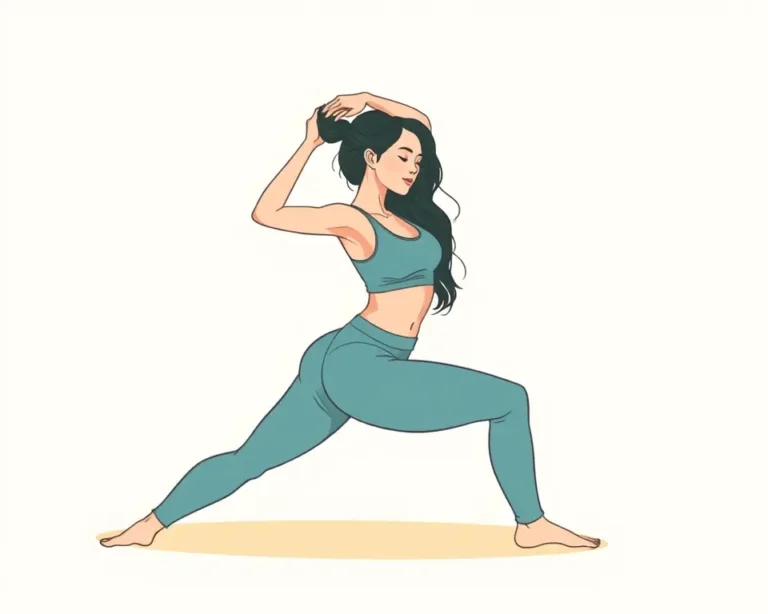Bhagyashree, the Bollywood actress known for her dedication to fitness, has shared three easy stretches to help achieve flexible hips. These stretches, which can be easily incorporated into a daily routine, are designed to improve mobility and reduce stiffness in the hip area.
Understanding the Importance of Hip Flexibility
Hip flexibility is crucial for overall mobility and plays a significant role in various physical activities. Tight hips can lead to discomfort, limited range of motion, and even pain in the lower back and knees. Regular stretching can improve hip flexibility, enhancing athletic performance and reducing the risk of injuries.
Benefits of Flexible Hips
- Improved mobility: Flexible hips allow for a greater range of motion, making everyday tasks easier.
- Reduced pain: Stretching can alleviate pain and stiffness in the hips, lower back, and knees.
- Enhanced athletic performance: Increased hip flexibility can improve performance in activities like running, yoga, and dancing.
- Better posture: Flexible hips contribute to better alignment and posture.
Bhagyashree’s Recommended Hip Stretches
Bhagyashree has highlighted three simple yet effective stretches that can be performed by anyone, regardless of their fitness level, to enhance hip flexibility.
1. Butterfly Stretch
The butterfly stretch is a gentle exercise that targets the inner thighs and hip flexors.
- How to perform: Sit on the floor with your knees bent and the soles of your feet together.
- Gently pull your heels towards your body.
- Hold your feet with your hands and keep your back straight.
- Gently flap your knees up and down like the wings of a butterfly.
- Continue for 30-60 seconds, focusing on relaxing your hip muscles.
2. Pigeon Pose
The pigeon pose is an advanced stretch that deeply opens the hips and improves flexibility.
- How to perform: Start in a plank position and bring your right knee towards your right wrist.
- Angle your right shin so that your right heel is pointing towards your left hip.
- Slide your left leg back, straightening your knee and pointing your toes.
- Lower your hips towards the floor, ensuring your right hip is as close to the floor as possible.
- If you’re flexible enough, lower your chest towards the floor and extend your arms forward.
- Hold the pose for 30-60 seconds, then repeat on the other side.
3. Hip Flexor Stretch
This stretch targets the hip flexors, which are often tight due to prolonged sitting.
- How to perform: Kneel on your right knee.
- Place your left foot flat on the floor in front of you, with your left knee bent at a 90-degree angle.
- Push your hips forward, feeling a stretch in the front of your right hip.
- Raise your right arm overhead to deepen the stretch.
- Hold the pose for 30-60 seconds, then repeat on the other side.
Tips for Performing Hip Stretches
To maximize the benefits of these stretches and avoid injuries, keep the following tips in mind:
- Warm-up: Before stretching, do some light cardio or dynamic movements to warm up your muscles.
- Proper form: Maintain correct posture and alignment during each stretch.
- Listen to your body: Never force a stretch. Stop if you feel pain and gradually increase the intensity over time.
- Breathe deeply: Focus on your breath to relax your muscles and deepen the stretch.
- Consistency: Incorporate these stretches into your daily routine for best results.
- Consult a professional: If you have any underlying health conditions or injuries, consult a healthcare professional before starting a new exercise program.
- Engage Core Muscles: Activating your core muscles during stretching not only protects your spine but also enhances the effectiveness of the stretches by promoting stability and proper alignment.
- Use Props When Needed: If you find it challenging to reach certain positions, don’t hesitate to use props like yoga blocks or straps to support your body and gradually increase your flexibility.
- Stay Hydrated: Drinking enough water helps lubricate your joints and muscles, making them more pliable and less prone to injury during stretching.
- Stretch Both Sides Equally: Ensure that you dedicate equal time and attention to stretching both sides of your body to maintain balance and symmetry.
Additional Stretches to Improve Hip Flexibility
While Bhagyashree highlighted three stretches, several other exercises can also contribute to improved hip flexibility.
1. Figure-Four Stretch
The figure-four stretch is a variation of the pigeon pose that can be done lying down, making it more accessible for beginners.
- How to perform: Lie on your back with your knees bent and your feet flat on the floor.
- Cross your right ankle over your left thigh, just above the knee.
- Reach through your legs and pull your left thigh towards your chest.
- Hold the pose for 30-60 seconds, then repeat on the other side.
2. Standing Hamstring Stretch
Tight hamstrings can contribute to hip stiffness. This stretch can help improve both hamstring and hip flexibility.
- How to perform: Stand with your feet hip-width apart.
- Bend forward from your hips, keeping your back straight.
- Reach towards your toes, or as far as you can comfortably go.
- Hold the pose for 30-60 seconds, feeling a stretch in the back of your legs.
3. Garland Pose (Malasana)
This deep squat opens the hips and stretches the ankles, groins, and back torso.
- How to perform: Stand with your feet slightly wider than hip-width apart, toes pointed slightly outward.
- Squat down as low as you can, keeping your heels on the ground.
- Bring your palms together in front of your chest in a prayer position, and use your elbows to gently push your knees apart.
- Keep your back straight and your chest lifted.
- Hold the pose for 30-60 seconds.
Common Causes of Tight Hips
Understanding the causes of tight hips can help you address the underlying issues and prevent further stiffness.
- Sedentary lifestyle: Prolonged sitting can cause the hip flexors to shorten and tighten.
- Lack of exercise: Insufficient physical activity can lead to muscle stiffness and reduced flexibility.
- Poor posture: Incorrect posture can strain the hip muscles and contribute to tightness.
- Age: As we age, our muscles naturally lose elasticity, leading to decreased flexibility.
- Injury: Hip injuries can cause inflammation and stiffness, limiting range of motion.
- Overuse: Repetitive movements or overuse of the hip muscles can lead to tightness and discomfort.
- Dehydration: Lack of proper hydration can cause muscles to become stiff and less flexible.
- Stress: Stress can cause muscles to tense up, contributing to hip tightness.
Benefits of Incorporating Hip-Opening Stretches into Your Routine
Adding hip-opening stretches to your daily routine can yield numerous physical and mental health benefits.
Physical Benefits
- Enhanced athletic performance: Improved hip flexibility translates to better performance in sports and other physical activities.
- Reduced risk of injury: Flexible hips reduce the risk of strains, sprains, and other injuries.
- Improved posture: Balanced hip muscles contribute to better posture and alignment.
- Increased range of motion: Greater hip flexibility makes everyday movements easier and more comfortable.
- Pain relief: Stretching can alleviate pain and discomfort in the hips, lower back, and knees.
Mental Benefits
- Stress reduction: Stretching helps release tension and promote relaxation.
- Improved body awareness: Regular stretching increases awareness of your body and its movements.
- Enhanced mood: Physical activity, including stretching, releases endorphins that improve mood and reduce anxiety.
- Greater sense of well-being: Improved physical health and comfort contribute to an overall sense of well-being.
Lifestyle Adjustments to Support Hip Flexibility
In addition to stretching, several lifestyle adjustments can support hip flexibility and overall health.
- Regular exercise: Engage in regular physical activity, including cardio, strength training, and flexibility exercises.
- Maintain a healthy weight: Excess weight can put extra strain on your hips and joints.
- Practice good posture: Be mindful of your posture when sitting, standing, and walking.
- Stay hydrated: Drink plenty of water to keep your muscles and joints lubricated.
- Take breaks from sitting: If you work at a desk, take regular breaks to stand up, stretch, and move around.
- Use ergonomic furniture: Invest in a comfortable chair and desk that support good posture.
- Get enough sleep: Adequate sleep is essential for muscle recovery and overall health.
- Manage stress: Practice stress-reducing activities like yoga, meditation, or spending time in nature.
- Balanced Diet: A diet rich in anti-inflammatory foods like fruits, vegetables, and omega-3 fatty acids can help reduce inflammation in the hips and promote overall joint health.
- Mindful Movement: Incorporate mindful movement practices like Tai Chi or Qi Gong into your routine to improve body awareness and promote gentle stretching and flexibility.
- Regular Massage: Consider getting regular massages to release tension in the hip muscles and improve circulation, further enhancing flexibility and reducing discomfort.
- Avoid Prolonged Sitting: If you have a job that requires prolonged sitting, make it a point to stand up and walk around every 20-30 minutes to prevent stiffness and tightness in the hips.
Bhagyashree’s Holistic Approach to Fitness
Bhagyashree’s fitness routine extends beyond just stretching. She emphasizes a holistic approach to health that includes a balanced diet, regular exercise, and mental well-being. Her dedication to fitness serves as an inspiration to many, encouraging people to prioritize their health and well-being.
Bhagyashree’s Diet and Lifestyle Tips
- Eat a balanced diet: Focus on whole, unprocessed foods, including fruits, vegetables, lean protein, and healthy fats.
- Stay active: Incorporate regular exercise into your routine, including cardio, strength training, and flexibility exercises.
- Get enough sleep: Aim for 7-8 hours of quality sleep per night.
- Manage stress: Practice stress-reducing activities like yoga, meditation, or spending time in nature.
- Stay hydrated: Drink plenty of water throughout the day.
- Listen to your body: Pay attention to your body’s signals and adjust your routine as needed.
Conclusion: Embracing Hip Flexibility for a Healthier Lifestyle
Incorporating Bhagyashree’s recommended hip stretches into your daily routine can significantly improve your hip flexibility, mobility, and overall well-being. By combining these stretches with a healthy lifestyle, you can enjoy a more active, comfortable, and fulfilling life. Remember to listen to your body, practice proper form, and consult a professional if you have any concerns. With consistency and dedication, you can achieve flexible hips and reap the numerous physical and mental benefits that come with it.







